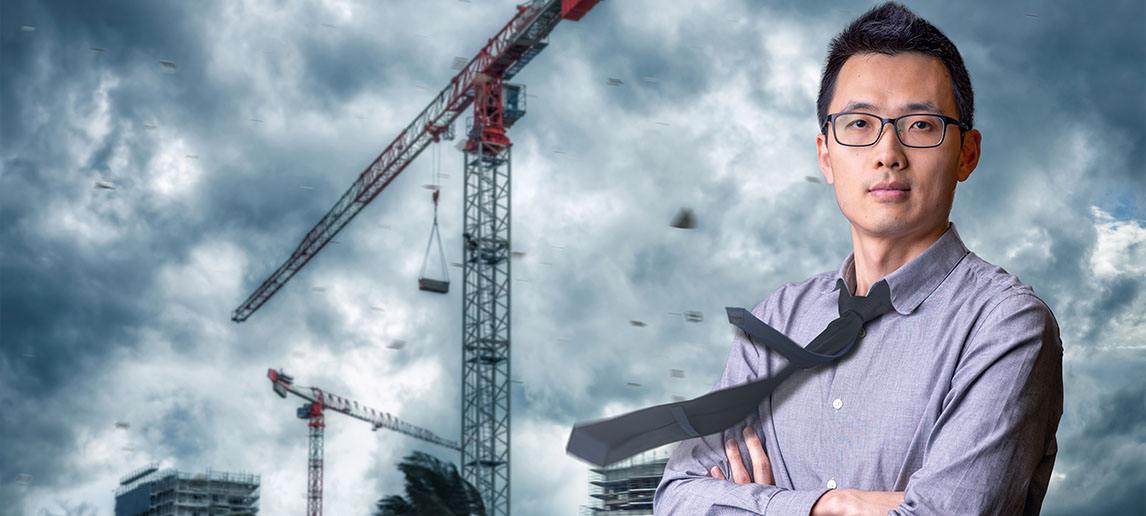How automation can protect construction jobsites from hurricane damage
The widespread unease that accompanies the menacing churn of an approaching hurricane is shared by construction managers, whose projects are exposed to a storm’s fury.
A lot of damage can happen fast to a jobsite in a hurricane’s path.
“Cranes and other heavy equipment are vulnerable to high winds or flying debris,” said Youngjib Ham, Texas A&M assistant professor of construction science. “Loose materials, jobsite machinery, and equipment can become projectiles that wreak havoc on the site, machinery and surrounding areas.”
Ham is addressing this issue by developing a groundbreaking, automated risk assessment system as an alternative to the industry’s current practice of time- consuming, labor-intensive manual inspections.
His project, funded by a $50,000 grant from the National Science Foundation, could help prevent some hurricane- related jobsite losses, which can easily run into the hundreds of millions of dollars.
There are, unfortunately, plenty of examples of catastrophic, hurricane-related jobsite losses. In 2005, Hurricane Katrina caused $275 million in damages at a New Orleans convention center jobsite.
In 2012, Hurricane Sandy caused more than $185 million in damage to New York’s World Trade Center construction project and nearby areas.
“Sandy’s winds blew debris off the jobsite, damaging neighboring transportation systems and buildings, triggering serious economic losses in the city,” said Ham.
In 2005, Hurricane Wilma’s destructive path included $4.2 million in damage to a construction project at the Miami International Airport’s South Terminal.
Losses like these could get worse as climate change is expected to deliver more frequent, more intense hurricanes.
“The potential exists for increased hurricane-related jobsite losses due to climate change, and because a large portion of construction projects are in urban areas,” said Ham, noting that two-thirds of the world’s population is expected to live in these areas by 2050.
Ham’s automated, risk assessment system that he calls “scene understanding technology” is intended to help construction site managers quickly identify the elements of a site that are particularly vulnerable to hurricane damage so that action can be taken to minimize losses.
Ham’s application starts with drone and handheld footage of the site that already exists as an ordinary part of the construction process. The app will “view” the footage, then utilize algorithms to convert the visual data into a simulation module that identifies sources of potential risk.
“The application will provide a crucial ‘heads-up’ for construction managers to quickly locate the risk of potential wind-borne debris prior to the arrival of hurricane-force winds and give them the time to implement proactive measures,” he said.
“Automatically generated action plans customized for individual construction sites will help builders more efficiently protect their jobsites from severe weather events, which can reduce damage to minimize effects on their performance, profitability or productivity,” said Ham.
The app will also create scenarios detailing the damage vulnerability of the site’s surrounding areas — to crane damage, flying debris, etc., so that property owners and/or residents can prepare for the “fallout” from the winds at the site.
To develop the system, Ham did pioneering research at the Wall of Wind, a giant, 72,000 square-foot hurricane simulator at Florida International University that’s capable of producing 157 mile-per-hour winds.
“I tested the effects of hurricane-force wind on models of construction sites in different areas; a high-rise area in downtown Miami, a suburban, low-rise location, and open terrain to determine the wind effects on jobsites in a variety of settings,” said Ham.
“It’s the first time such detailed experimentation regarding wind effects on construction sites has been conducted,” he said.
His findings of the effects of hurricane-force winds on cranes in a high-rise area is the first of its kind, and, he said, “will result in a unique dataset of great value to the research community.”
“Ultimately, this research will provide a crucial heads- up for construction managers to quickly locate the risk of potential wind-borne debris prior to hurricanes and quickly implementing damage prevention measures,” he said.
Ham’s project funding comes from the NSF’s I-Corps program, which supports researchers looking to translate a promising idea from the research lab to the marketplace.
Youngjib Ham
Associate Professor, Holder of the History Maker Homes Endowed Professorship
979.458.0184 Email Youngjib Ham
